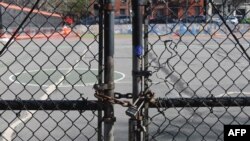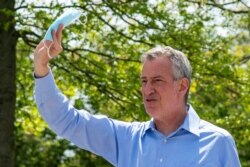New York City’s mayor laid out his administration’s plan Friday to reopen the largest public-school system in the United States in September, as the onetime coronavirus hotspot has brought its infection rate under control.
“Everything we do is going to be focused on health and safety – health and safety for our kids, our families, our educators, our school staff,” Mayor Bill de Blasio told reporters.
New York’s 1.1 million public school students were sent home in mid-March as the coronavirus took hold in the city. Officials and educators acted quickly to move classes online, getting hundreds of thousands of computers and tablets to low-income students and supplying them with Internet connections.
For many children, school is also where they get their main meal of the day, so the city distributed meals to-go at more than 400 school sites.
The effort was herculean in scale, faced numerous challenges, and was met with mixed reviews. But officials and parents agree that remote learning cannot replace the classroom experience. The city received 400,000 responses to a survey, and de Blasio said 75% of parents want their kids back in the physical classroom.
“Overwhelmingly, the model here is the blended approach with two or three days in school each week, which is really going to benefit kids,” he said of how things will look in September.
During the other days, remote learning would continue in order to limit the number of students in each school. He said full-time remote learning is available to any family that prefers it.
In addition, social distancing guidelines will be in place in every part of the school buildings, and free face coverings, personal protective equipment and priority testing will be available for everyone in the school community. Students will stay in a single classroom as much as possible, with very few adults in contact with them.
“The whole idea of this plan is to limit the amount of movement in the school, limit the amount of people coming in contact with each other, keep kids as much as possible in the same group all day long for everyone's protection,” the mayor said.
The mayor’s plan has not been warmly received by the city’s teachers unions, which say safety and logistical arrangements are inadequate.
In addition to the precautions, reopening will be conditioned on the citywide infection rate, which must be below 3%. De Blasio said it has been under that threshold for the past six weeks.
“That's extraordinary,” he said.
If the infection rate rises above 3%, students would shift completely to remote learning until it stabilizes.
Many other states are using a 5% threshold, but the mayor said that due to New York’s density and its experience with the virus, officials want to be more vigilant in preventing a surge in infections, hence the lower threshold.
In March and April, New York City was the U.S. epicenter of COVID-19, the disease caused by the coronavirus. By the end of April, the city recorded more than 160,000 cases and more than 12,000 deaths. On Friday, the mayor said that in the past 24 hours there were 312 new confirmed cases and only 1% of residents tested for the virus had it.
The city also has contingency plans covering the possibility of a student or teacher testing positive, including a 14-day quarantine.
“If an illness does occur, we will respond quickly, communicate clearly during investigations and promptly to share decisions to quarantine classrooms, or if necessary, close schools,” said Schools Chancellor Richard Carranza.








